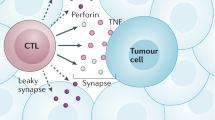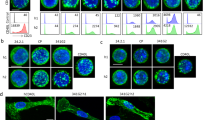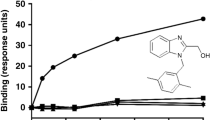Abstract
THE remarkable ability of tumour necrosis factor (TNF), especially in combination with interferon, selectively to kill or inhibit malignant cell lines is so far unmatched by any other combination of cytokines1–4. But clinical trials in cancer patients have on the whole been disappointing5–7, and it has been estimated that a TNF dose would be effective only at 5–25 times the maximum tolerated dose4. High TNF concentrations give a much more pronounced antitumour activity in mice1,8–10, in which murine TNF is about 50-fold more systemically toxic than human TNF11,12. But there is little or no species specificity in cytotoxicity of murine TNF and human TNF on human as well as on murine cell lines13,14. This dual action of TNF may be explained by the existence of two types of receptor for TNF15,16: the smaller, TNF-R55, is present on most cells and particularly on those susceptible to the cytotoxic action of TNF17; the larger, TNF-R55, is also present on many cell types15,16, especially those of myeloid origin, and is strongly expressed on stimulated T and B lymphocytes18. In mice, human TNF binds only to murine TNF-R55 (ref. 15), which can then mediate cytotoxic activity on malignant cells15–17,19. As human TNF does not bind to murine TNF-R75, the latter must be responsible for the much enhanced systemic toxicity of murine TNF. Human TNF can, however, become toxic in mice when a second pathway is activated1,11,20. There is no reciprocal situation in the human system: human and murine TNF bind almost equally well to the two human TNF receptors. Here we describe human TNF mutants that still interact with the human TNF-R55 receptor but which have largely lost their ability to bind to human TNF-R75. Activation of TNF-R55 is sufficient to trigger cytotoxic activity towards transformed cells. One representative human TNF mutant retains its antitumour activity in nude mice carrying tumours derived from human cancers. Under the appropriate conditions, such human TNF mutants are expected to induce less systemic toxicity in man, while still exerting their direct antitumour effect.
This is a preview of subscription content, access via your institution
Access options
Subscribe to this journal
Receive 51 print issues and online access
$199.00 per year
only $3.90 per issue
Buy this article
- Purchase on Springer Link
- Instant access to full article PDF
Prices may be subject to local taxes which are calculated during checkout
Similar content being viewed by others
References
Fiers, W. FEBS Lett. 285, 199–212 (1991).
Sugarman, B. J. et al. Science 230, 943–945 (1985).
Fransen, L., Van der Heyden, J., Ruysschaert, R. & Fiers, W. Eur. J. Cancer clin. Oncol. 22, 419–426 (1986).
Old, L. J. in Tumor Necrosis Factor: Structure, Mechanism of Action, Role in Disease and Therapy (eds Bonavida, B. & Granger, G.) 1–30 (Karger, Basel, 1990).
Spriggs, D. R. & Yates, S. W. in Tumor Necrosis Factors: The Molecules and Their Emerging Role in Medicine (ed. Beutler, B.) 383–406 (Raven, New York, 1992).
Taguchi, T. & Sohmura, Y. Biotherapy 3, 177–186 (1991).
Uenard, D., Lejeune, F., Delmotte, J.-J., Renard, N. & Ewalenko, P. J. clin. Oncol. 10, 52–60 (1992).
Brouckaert, P. G. G., Leroux-Roels, G. G., Guisez, Y., Tavernier, J. & Fiers, W. Int. J. Cancer 38, 763–769 (1986).
Malik, S. T. A. & Balkwill, F. R. in Tumor Necrosis Factors. Structure, Function, and Mechanism of Action (eds Aggarwal, B. B. & Vilc̆ek. J.) 239–268 (Dekker, New York, 1992).
Takahashi, N., Brouckaert, P. & Fiers, W. Cancer Res. 51, 2366–2372 (1991).
Everaerdt, B., Brouckaert, P., Shaw, A. & Fiers, W. Biochem. biophys. Res. Commun. 163, 378–385 (1989).
Brouckaert, P., Libert, C., Everaerdt, B. & Fiers, W. Lymph. Cyt. Res. 11, 193–196 (1992).
Fransen, L., Ruysschaert, M. R., Van der Heyden, J. & Fiers, W. Cell. Immun. 100, 260–267 (1986).
Kramer, S. M. et al. Cancer Res. 48, 920–925 (1988).
Tartaglia, L. A. & Goeddel, D. V. Immun. Today 13, 151–153 (1992).
Loetscher, H., Steinmetz, M. & Lesslauer, W. Cancer Cells 3, 221–226 (1991).
Brockhaus, M. et al. Proc. natn. Acad. Sci. U.S.A. 87, 3127–3131 (1990).
Gehr, G., Gentz, R., Brockhaus, M., Lötscher, H. & Lesslauer, W. J. Immun. 149, 911–917 (1992).
Tartaglia, L. A. et al. Proc. natn. Acad. Sci. U.S.A. 88, 9292–9296 (1991).
Brouckaert, P., Everaerdt, B. & Fiers, W. Eur. J. Immun. 22, 981–986 (1992).
Van Ostade, X., Tavernier, J., Prangé, T. & Fiers, W. EMBO J. 10, 827–836 (1991).
Yamagishi, J. et al. Protein Engng. 3, 713–719 (1990).
Plaetinck, G., Declercq, W., Tavernier, J., Nabholz, M. & Fiers, W. Eur. J. Immun. 17, 1835–1838 (1987).
Vandenabeele, P. et al. Lymphokine Res. 9, 381–389 (1990).
Heller, R. A., Song, K., Fan, N. & Chang, D. J. Cell 70, 47–56 (1992).
Lesslauer, W. et al. Eur. J. Immun. 21, 2883–2886 (1991).
Conzelmann, A., Corthésy, P., Cianfriglia, M., Silva, A. & Nabholz, M. Nature 298, 170–172 (1982).
de la Luna, S., Soria, I., Pulido, D., Ortin J. & Jiménez, A. Gene 62, 121–126 (1988).
Author information
Authors and Affiliations
Rights and permissions
About this article
Cite this article
Ostade, X., Vandenabeele, P., Everaerdt, B. et al. Human TNF mutants with selective activity on the p55 receptor. Nature 361, 266–269 (1993). https://doi.org/10.1038/361266a0
Received:
Accepted:
Published:
Issue Date:
DOI: https://doi.org/10.1038/361266a0
This article is cited by
-
STAT1 mediates transmembrane TNF-alpha-induced formation of death-inducing signaling complex and apoptotic signaling via TNFR1
Cell Death & Differentiation (2017)
-
Peptide-Mediated Targeting of Cytokines to Tumor Vasculature: The NGR-hTNF Example
BioDrugs (2013)
-
Heterogeneity reduces sensitivity of cell death for TNF-Stimuli
BMC Systems Biology (2011)
-
The −383A>C TNFRI polymorphism is associated with soluble levels and clinical activity in rheumatoid arthritis
Rheumatology International (2010)
-
Role of Cytokines as Mediators and Regulators of Microglial Activity in Inflammatory Demyelination of the CNS
NeuroMolecular Medicine (2010)
Comments
By submitting a comment you agree to abide by our Terms and Community Guidelines. If you find something abusive or that does not comply with our terms or guidelines please flag it as inappropriate.



